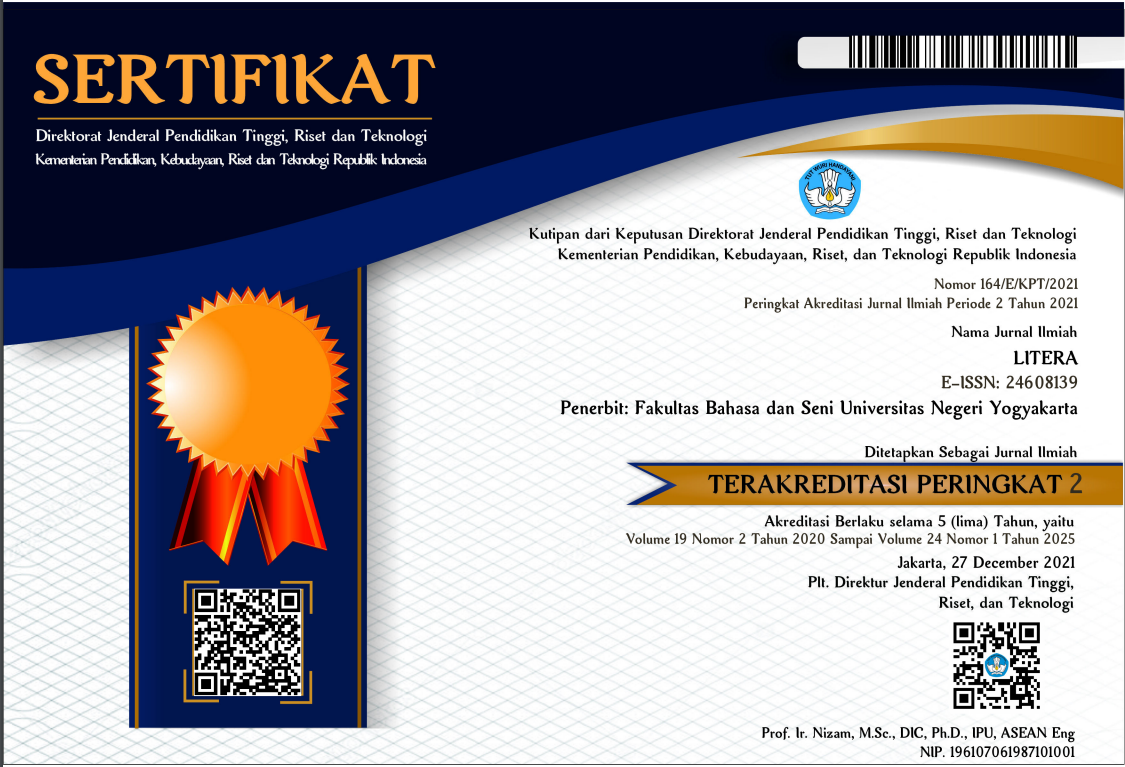PERLOKUSI HOAKS COVID-19: PERSPEKTIF CYBERPRAGMATICS
Abstract
Hoaks adalah berita palsu yang menggunakan bahasa sebagai medianya, tetapi bukan bahasa dalam fungsi sesungguhnya. Penelitian ini bertujuan mendeskripsikan perlokusi hoaks Covid-19 di media sosial. Perspektif yang digunakan adalah Cyberpragmatics. Pendekatan yang diterapkan adalah deskriptif kualitatif. Objek sasaran penelitian ini adalah manifestasi perlokusi hoaks Covid-19. Data penelitian berupa cuplikan-cuplikan tuturan yang di dalamnya terdapat manifestasi-manifestasi perlokusi hoaks Covid-19. Sumber data substantif penelitian ini teks-teks tertulis yang terdapat di media sosial. Adapun sumber data lokasionalnya adalah media-media sosial seperti Instagram, Facebook, Blog, Webs, yang hadir di sekitar waktu penelitian. Data dikumpulkan dengan metode simak. Teknik yang digunakan adalah teknik rekam dan teknik catat. Sebelum dilakukan analisis data, validitas data dipastikan terlebih dahulu dengan triangulasi data. Metode analisis yang diterapkan adalah metode analisis ekstralingual. Adapun teknik yang diterapkan adalah teknik hubung banding khususnya teknik hubung banding menyamakan. Penelitian ini menghasilkan temuan perlokusi hoaks Covid-19 berikut ini: (1) mengentalkan rasa sentimen; (2) menumbuhkan perspepsi keliru; (3) menyindir otoritas; (4) menumbuhkan kegaduhan; (5) menebar ketakutan; (7) menumbuhkan kekhawatiran; dan (8) menumbuhkan kasak-kusuk.
Kata Kunci: Cyberpragmatics, konteks eksternal virtual, dampak perlokusi
Abstract
Hoax is fake news that uses language as the medium, but not language in its true function. The main objective of this study is to describe the perlocutionary impact of Covid-19 hoaxes. The research perspective used was cyberpragmatics. The approach applied was descriptive qualitative. The object of this research was the manifestation of Covid-19 perlocutionary hoaxes. The research data were snippets of speech in which there were manifestations of Covid-19 hoaxes. The substantive data source of this research was written texts contained in the social media. The locational data sources were social media such as Instagram, Facebook, Blogs, Webs, which were present around the time of research. Data were collected by applying the listening method. The technique used was the recording technique and note taking technique. Before data analysis was performed, the validity of the data was confirmed in advance by applying data triangulation. The data analysis method applied was the extra-lingual analysis method or the extra-lingual equivalent analysis method. The technique applied was the appeal link technique, especially the equalization link technique. This study produced the following findings of the impacts of Covid-19 perlocutionary hoaxes, namely (1) making thickened sentiment; (2) fostering wrong perceptions; (3) insinuating authority; (4) creating noise; (5) spreading fear; (6) fostering concern; (7) growing gossips.
Keywords: Cyberpragmatics, virtual external context, perlocutionary impacts
Keywords
Full Text:
PDFReferences
Burger, J. M. (2014). Obedience. In The Oxford Handbook of Social Influence. https://doi.org/10.1093/oxfordhb/9780199859870.013.5
Chen, J. (2017). Research Trends in Intercultural Pragmatics. Australian Journal of Linguistics. https://doi.org/10.1080/07268602.2016.1204903
Cyber, K. C. (2004). Karakteristik cerpen-cerpen, 190–203.
Handayani, T. K. (2016). Nilai-Nilai Karakter Dalam Tindak Tutur Ilokusi Dalam Buku Wir Besuchen Eine Moschee. Litera, 15(2), 305–318. https://doi.org/10.21831/ltr.v15i2.11831
Hassall, T. (2012). Sociopragmatics is slower: A reply to Chang. Language Sciences. https://doi.org/10.1016/j.langsci.2011.12.001
Kecskes, I. (2012). Sociopragmatics and cross-cultural and intercultural studies. In The Cambridge Handbook of Pragmatics. https://doi.org/DOI: 10.1017/CBO9781139022453.033
Kramsch, C. (2002). Language and Culture: A Social Semiotic Perspective. Adfl. https://doi.org/10.1632/adfl.33.2.8
Kuhn, E. D. (1984). Speech act theory and pragmatics. Journal of Pragmatics. https://doi.org/10.1016/0378-2166(84)90068-7
Locher, M. A. (2013). Cyberpragmatics: Internet-Mediated Communication in Context. Journal of Pragmatics. https://doi.org/10.1016/j.pragma.2012.12.002
Locher, M. A. (2015). Interpersonal pragmatics and its link to (im)politeness research. Journal of Pragmatics. https://doi.org/10.1016/j.pragma.2015.05.010
Mahsun, M. (2005). Metode Penelitian Bahasa. Jakarta: PT Raja Grafindo Persada. https://doi.org/10.1200/JCO.2008.17.1991
Martin, T. (1995). Cultural Contexts. Ethics & Behavior. https://doi.org/10.1207/s15327019eb0503_11
Mey, J. L. (2003). Context and (dis)ambiguity: A pragmatic view. Journal of Pragmatics. https://doi.org/10.1016/S0378-2166(02)00139-X
Mey, J. L. (2004). Pragmatics: An Introduction. Pragmatics. https://doi.org/10.1353/lan.2004.0045
Mey, J. L. L., Brown, K., & Mey, J. L. L. (2006). Pragmatics: Overview. In Encyclodpedia of language and linguistics. https://doi.org/10.1002/9781405198431.wbeal1338
Pranowo, P. (2020). Perspektif Masyarakat Jawa Terhadap Pemakaian Bahasa Nonverbal: Studi Kasus Etnopragmatik. Litera, 19(1), 52–71. https://doi.org/10.21831/ltr.v19i1.28873
Rahardi, R. K. (2017). Linguistic Impoliteness in The Sociopragmatic Perspective. Jurnal Humaniora. https://doi.org/10.22146/jh.v29i3.24954
Sheira Ayu Indrayani dan Citra Aulia Johansari. (2019). Cyberbullying Use on Teenage Artists and Its Implications. Litera, 18(2), 275–296.
Spencer-Oatey, H., & Jiang, W. (2003). Explaining cross-cultural pragmatic findings: Moving from politeness maxims to sociopragmatic interactional principles (SIPs). Journal of Pragmatics. https://doi.org/10.1016/S0378-2166(03)00025-0
Sperber, D., & Wilson, D. (2012). Pragmatics, modularity and mindreading. In Meaning and Relevance. https://doi.org/10.1017/CBO9781139028370.016
Sudaryanto. (2015). Metode dan Aneka Teknik Analisis Bahasa: Pengantar Penelitian Wahana Kebudayaan secara Linguistis (1st ed.). Yogyakarta: Sanata Dharma University Press.
Sudaryanto. (2016). Metode dan Aneka Teknik Analisis Bahasa (1st ed.). Yogyakarta: Sanata Dharma University Press.
Taguchi, N. (2015). “Contextually” speaking: A survey of pragmatic learning abroad, in class, and online. System. https://doi.org/10.1016/j.system.2014.09.001
Wijana, I. D. P. (2014). Bahasa, Kekuasaan, Dan Resistansinya: Studi Tentang Nama-Nama Badan Usaha Di Daerah Istimewa Yogyakarta. Jurnal Humaniora.
Wilson, D. (2003). Relevance and lexical pragmatics. Pragmatics.
Wilson, N. (2017). Linguistic ethnography. In The Routledge Handbook of Language in the Workplace. https://doi.org/10.4324/9781315690001
Yus, F. (2003). Humor and the search for relevance. Journal of Pragmatics. https://doi.org/10.1016/S0378-2166(02)00179-0
Yus, F. (2011). Cyberpragmatics, Internet-mediated communication in context. (A. Fetzer, Ed.) (1st ed.). Amsterdam: John Benjamin Publishing Company. Retrieved from https://benjamins.com
Zamzani, Z., Rahayu, Y. E., & Maslakhah, S. (2017). Eksistensi Bahasa Dalam Iklan Televisi Indonesia. Litera, 16(2), 249–264. https://doi.org/10.21831/ltr.v16i2.15971
https://nasional.kompas.com/read/2020/04/18/18201881/menkominfo-sebut-ada-554-isu-hoaks-tentang-covid-19.
DOI: https://doi.org/10.21831/ltr.v19i3.31469
Refbacks
- There are currently no refbacks.
______________________
__________________________________________________________________________________________________
Litera Journal is published by the Faculty of Languages, Arts, and Culture Universitas Negeri Yogyakarta in collaboration with Himpunan Sarjana Kesusasteraan Indonesia (HISKI)
The International Journal of Linguistic, Literature, and Its Teaching at http://http://journal.uny.ac.id/index.php/litera/ is licensed under a Creative Commons Attribution-ShareAlike 4.0 International License
__________________________________________________________________________________________________















